FDMC Red Book February 2024
In This Issue
Troubleshooting ripsaw wedges, unsquared edges & poor glue joints
Tips & tricks for ensuring quality cuts and joints on the ripsaw.
What makes up hardwood lumber pricing?
It can be interesting to think about how lumber goes from the forest to the manufacturing plant. When you add each phase together you can get a good picture of the key elements that impact the overall total of the hardwood lumber pricing.
Solving crosscut, wood planing & other issues
The Wood Doctor answers questions on steamed walnut issues, joint failures at the chop saw, planing and other solid wood machining problems.
Five key factors for choosing the right CNC router
It pays to look at ROI, configuration, software, workflow, and maintenance before selecting a CNC router.
Five ways to tell when your CNC control needs upgrading
To keep your CNC machines in production, inspect these five components to determine if you could benefit from a controller upgrade.
Edgebander glue pot tips
Here are a few other pointers that will help you to keep your glue applicator in good working condition between rebuilds.
CNC vs. conventional machining
While CNC machines make the process of designing, cutting, and building products more sophisticated and easy to carry out, what’s the real difference between using CNC and conventional machining?
Creating a vacuum hold-down standard
The perfect vacuum seal starts with the preparation of the vacuum system consisting of the CNC matrix table, the correct sealing CNC gasket and the MDF spoilboard.
Cutting & Grinding (Cutting Tools & Grinders)
Clean your collet, improve your performance
Increase the life span of a collet and toolholder with these easy steps.
Cutting & Grinding (Cutting Tools & Grinders)
Tooling tips to remember
Here are some helpful tips to get the most out of your tools.
Cutting & Grinding (Cutting Tools & Grinders)
Got a damaged or dull tool?
The goal is to make sure that your investment is maintained to the highest quality standard in the industry.
Gluing, Laminating & Veneering
How to store & handle particleboard & MDF
Key tips to ensure optimal performance of composite panels.
Gluing, Laminating & Veneering
3 troubleshooting tips for processing veneer
What follows are some possible problems, causes and solutions regarding the burning, burnishing and crimping of veneer on the splicer.
Gluing, Laminating & Veneering
Roll coaters & glue spreaders: What’s the difference?
Roll coaters and adhesive spreaders (also called glue spreaders) are very similar, but there are some unique differences. Typically, adhesive spreaders will be used to bond two materials together and the applied adhesive will not be visible in the final product. With a roll coater the coating typically will be visible in the final product and will have a certain pattern or look, for example a gloss finish.
Top 8 finishing challenges & solutions
Follow these tips to achieve a quality finish.
Solving snake lines & other widebelt sanding flaws
Troubleshooting tips to eliminate snake or oscillation lines, raised lines, grooves, blotchy finishes and chatter marks.
6 tips for sanding veneer
For optimal sanding of veneer products consistently, sanders should be configured with:1. Conveyor with variable feed speed. The ability to adjust feed speed is critical to maintaining consistency when veneer sanding. Controlling the “dwell” time under the sanding platen directly affects the amount of material removed. Single and two-speed drive motors do not have enough adjustment to dial in the correct “dwell” time for each wood species or veneer type. speed of the conveyor should be between 9-12 mpm depending on the veneer type.
Scratching the surface
When you sand, you are installing a series of scratches on the surface of that material to flatten it out to a point where it looks pleasing to the eye, feels smooth to the touch, and accepts an even coat of finish.
Components, Hardware & Assembly
Residential lighting and decor trends
Design experts share 2024 predictions.
Components, Hardware & Assembly
2024 interior design and material trends
According to Zillow, murals and Brutalism, a mid-20th-century design style, are expected to trend in 2024.
Components, Hardware & Assembly
3 keys to sourcing components
Tips on how to source materials for your business needs.
Components, Hardware & Assembly
3 essential commercial hardware tips
As health and safety provisions remain paramount to designers, a few of the basics for commercial hardware.
5-steps to a comprehensive compressed air assessment
The U.S. Energy Department estimates that air compressors use as much as 10% of all electricity generated in the U.S., and as much as 50% of this energy is wasted. Compressed air leaks alone account for 25-30% of compressed air use. Consequently, many industrial companies are identifying ways to lower their compressed air system energy consumption. One of the most popular methods to do so is a comprehensive compressed air assessment, or “air demand analysis.” The objective of this paper is to define the five steps required in a compressed air assessment.
Pin or pinless?
The fastest way to test the moisture content of wood is to use a moisture meter. There are two main types of wood moisture meters, pin-type and pinless.
There are more than just eight wastes!
Learn the 10 Commandments of lean manufacturing.
Traditional collectors vs. high-pressure collectors
Whether or not the air is clean or laden with dust, all air has mass. This means that as it moves, frictional forces slow it down. Making matters worse, friction increases as the air’s mass and speed increase. Friction is created by the air interacting with other materials, including the dust within it, the components it moves through (for example the hose, ductwork, along with other items), and the air itself.































